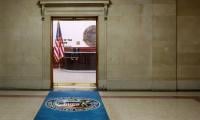Schools for scandal
While visiting a friend who teaches Urdu at the Government College, Gulberg in Lahore, I saw more than 180 students of the intermediate level squeezed in a classroom, sweating and breathing heavily in the hot, humid weather of September while listening to the lecture.On interviewing college teachers, it came out
By Adnan Adil
September 19, 2015
While visiting a friend who teaches Urdu at the Government College, Gulberg in Lahore, I saw more than 180 students of the intermediate level squeezed in a classroom, sweating and breathing heavily in the hot, humid weather of September while listening to the lecture.
On interviewing college teachers, it came out that this picture typifies most classrooms at government-run colleges in Punjab.
An English-language lecturer for FA classes at Government College, Gulberg for Girls, Ravi Road, Lahore says she needs at least 15 minutes out of 45 minute-period to take the roll call (attendance) of her 160 students. She used to address a class of 270 students at a college near Gujranwala before she was posted to her current position in Lahore.
Obviously, a teacher cannot be expected to provide quality education to such a mob of students whose attendance alone is quite a job for a lecturer who teaches five classes a day. By the way, in Lahore, college teachers are also required to check for dengue larvae at their institutions besides shepherding students to officially organised youth shows.
Crowded classrooms, a shortage of teachers and lack of necessary facilities such as alternative electricity supply during power outages, inadequate science laboratories and perfunctory libraries are defining features of a majority of the public-sector colleges in the province.
In these miserable conditions, it’s no surprise that this year not a single student appearing from 14 public colleges of Lahore passed the BA/BSc exams of Punjab University. Most students who obtained top positions across the province in this year’s intermediate examinations belong to private institutions.
Over the years, the average pass percentage of public colleges in intermediate and bachelor programmes does not go beyond 40 percent – and that too thanks to the fact that most students take private tuitions. Each year, more than half of the intermediate (grade 11 and 12) students drop out joining the unskilled, semi-educated hordes of unemployed youth in the country.
While the government is building two motorways from Lahore to Multan in addition to an existing double carriageway, it was apparently short of funds for building new colleges and recruiting an adequate number of teachers for the 400,000 students who enrolled in the public sector colleges after matriculation last year.
Nearly 5,000 college lecturer positions have been lying vacant in Punjab for the last several years. For a population of 100 million in 3,455 union councils in the province, there are only 550 public sector colleges with around 19,000 teachers.
During the last seven years of the PML-N rule, the emphasis of the Punjab government’s education policy has been on much-publicised stunts such as sending top position-holding students to foreign trips or distributing laptops.
When it comes to hardcore decisions about the public sector education system, the government gets cold feet. The official figures speak for themselves. Last month, 44,000 students appeared for 2,200 seats in Punjab’s public engineering colleges implying 20 candidates contesting for one seat.
Similarly, 47,559 students took a test for 4,305 seats in the province’s government-run medical colleges – 11 candidates for each seat. It’s evident that the public sector has failed to keep pace with growing population and demand for higher or professional education.
For 36 districts of the province, there are only 17 public sector medical colleges and three dental colleges. The government has left most of the students, including those achieving high marks, at the mercy of money-minting private sector that is free from any regulation.
In 2014-15, the Punjab Assembly passed a development budget of Rs11.6 billion for the higher education (including intermediate), but the administration spent only Rs6.3 billion – only 54 percent of the total allocation.
In contrast, the provincial assembly approved a development outlay of Rs31.6 billion for building roads whereas the government spent Rs41 billion on them – 129 percent of the original allocation.
Both teachers and the bureaucracy supervising them pass buck on each other for poor standards of college education. The Punjab Professor and Lecturers Association (PPLA) has been demanding of the provincial government to fill vacant posts and issue seniority list of teachers pending for the last 12 years but to no avail.
On their part, a large number of college teachers have been running their private tuition centres or private businesses even during the official duty hours. Absenteeism of teachers from their institutions and classes is quite rampant.
Since last year, the education department has somewhat improved its monitoring of the attendance of students and teachers at public colleges but this is effective only in big cities. Teachers’ absenteeism is still high in colleges situated in small cities and towns where lecturers visit institutions once or twice a week.
The higher education department needs to employ inspectors for colleges, as has been done for government-run schools, to monitor and inspect the attendance of students and teachers – especially in small cities and towns. These inspectors should also collect feedback from the students about the quality of teaching and other facilities like libraries and laboratories.
Most libraries in public colleges exist only in name while laboratories are in shambles. A strict monitoring and inspection regime needs to be put in place if billions of rupees from the public money are to be saved from going down the drain year after year.
As the number of students getting admission into intermediate classes is three times the ones enrolling for BA/BSc programmes, the pressure on colleges can be eased by transferring intermediate education to high schools as is the case in many other countries of the world.
At present, our public sector high schools have classes up to the 10th standard (grade). By upgrading high schools to 12 grades, it will also become easier to bring both students and teachers into discipline with an inspection system for public schools already in place.
Girl students living in remote areas, not being able to afford attending colleges usually located in cities far away from their homes, will also benefit from the intermediate classes in high schools as they exist in almost all union councils.
The number of public sector institutions providing 12 years of education needs to be increased at least six-fold – one high school up to 12-grade for each union council – if we want to see our young people become a productive part of society. Herding 180 or 250 students into each classroom serves no education purpose.
Email: adnanadilzaidi@gmail.com
On interviewing college teachers, it came out that this picture typifies most classrooms at government-run colleges in Punjab.
An English-language lecturer for FA classes at Government College, Gulberg for Girls, Ravi Road, Lahore says she needs at least 15 minutes out of 45 minute-period to take the roll call (attendance) of her 160 students. She used to address a class of 270 students at a college near Gujranwala before she was posted to her current position in Lahore.
Obviously, a teacher cannot be expected to provide quality education to such a mob of students whose attendance alone is quite a job for a lecturer who teaches five classes a day. By the way, in Lahore, college teachers are also required to check for dengue larvae at their institutions besides shepherding students to officially organised youth shows.
Crowded classrooms, a shortage of teachers and lack of necessary facilities such as alternative electricity supply during power outages, inadequate science laboratories and perfunctory libraries are defining features of a majority of the public-sector colleges in the province.
In these miserable conditions, it’s no surprise that this year not a single student appearing from 14 public colleges of Lahore passed the BA/BSc exams of Punjab University. Most students who obtained top positions across the province in this year’s intermediate examinations belong to private institutions.
Over the years, the average pass percentage of public colleges in intermediate and bachelor programmes does not go beyond 40 percent – and that too thanks to the fact that most students take private tuitions. Each year, more than half of the intermediate (grade 11 and 12) students drop out joining the unskilled, semi-educated hordes of unemployed youth in the country.
While the government is building two motorways from Lahore to Multan in addition to an existing double carriageway, it was apparently short of funds for building new colleges and recruiting an adequate number of teachers for the 400,000 students who enrolled in the public sector colleges after matriculation last year.
Nearly 5,000 college lecturer positions have been lying vacant in Punjab for the last several years. For a population of 100 million in 3,455 union councils in the province, there are only 550 public sector colleges with around 19,000 teachers.
During the last seven years of the PML-N rule, the emphasis of the Punjab government’s education policy has been on much-publicised stunts such as sending top position-holding students to foreign trips or distributing laptops.
When it comes to hardcore decisions about the public sector education system, the government gets cold feet. The official figures speak for themselves. Last month, 44,000 students appeared for 2,200 seats in Punjab’s public engineering colleges implying 20 candidates contesting for one seat.
Similarly, 47,559 students took a test for 4,305 seats in the province’s government-run medical colleges – 11 candidates for each seat. It’s evident that the public sector has failed to keep pace with growing population and demand for higher or professional education.
For 36 districts of the province, there are only 17 public sector medical colleges and three dental colleges. The government has left most of the students, including those achieving high marks, at the mercy of money-minting private sector that is free from any regulation.
In 2014-15, the Punjab Assembly passed a development budget of Rs11.6 billion for the higher education (including intermediate), but the administration spent only Rs6.3 billion – only 54 percent of the total allocation.
In contrast, the provincial assembly approved a development outlay of Rs31.6 billion for building roads whereas the government spent Rs41 billion on them – 129 percent of the original allocation.
Both teachers and the bureaucracy supervising them pass buck on each other for poor standards of college education. The Punjab Professor and Lecturers Association (PPLA) has been demanding of the provincial government to fill vacant posts and issue seniority list of teachers pending for the last 12 years but to no avail.
On their part, a large number of college teachers have been running their private tuition centres or private businesses even during the official duty hours. Absenteeism of teachers from their institutions and classes is quite rampant.
Since last year, the education department has somewhat improved its monitoring of the attendance of students and teachers at public colleges but this is effective only in big cities. Teachers’ absenteeism is still high in colleges situated in small cities and towns where lecturers visit institutions once or twice a week.
The higher education department needs to employ inspectors for colleges, as has been done for government-run schools, to monitor and inspect the attendance of students and teachers – especially in small cities and towns. These inspectors should also collect feedback from the students about the quality of teaching and other facilities like libraries and laboratories.
Most libraries in public colleges exist only in name while laboratories are in shambles. A strict monitoring and inspection regime needs to be put in place if billions of rupees from the public money are to be saved from going down the drain year after year.
As the number of students getting admission into intermediate classes is three times the ones enrolling for BA/BSc programmes, the pressure on colleges can be eased by transferring intermediate education to high schools as is the case in many other countries of the world.
At present, our public sector high schools have classes up to the 10th standard (grade). By upgrading high schools to 12 grades, it will also become easier to bring both students and teachers into discipline with an inspection system for public schools already in place.
Girl students living in remote areas, not being able to afford attending colleges usually located in cities far away from their homes, will also benefit from the intermediate classes in high schools as they exist in almost all union councils.
The number of public sector institutions providing 12 years of education needs to be increased at least six-fold – one high school up to 12-grade for each union council – if we want to see our young people become a productive part of society. Herding 180 or 250 students into each classroom serves no education purpose.
Email: adnanadilzaidi@gmail.com
-
 Kate Middleton Celebrates England Women's Rugby Stars After World Cup Win
Kate Middleton Celebrates England Women's Rugby Stars After World Cup Win -
 Kris Jenner Dubs Chicago West Her 'sweet Angel' As She Turns Eight
Kris Jenner Dubs Chicago West Her 'sweet Angel' As She Turns Eight -
 Josh Charles Credits Taylor Swift For His, Ethan Hawke’s Moon Person Trophies
Josh Charles Credits Taylor Swift For His, Ethan Hawke’s Moon Person Trophies -
 Jodie Foster Voices Opinion About 'misogyny'
Jodie Foster Voices Opinion About 'misogyny' -
 Virginia Madsen Remembers Late Brother Michael Madsen Six Months After His Death
Virginia Madsen Remembers Late Brother Michael Madsen Six Months After His Death -
 Emilia Clarke Reveals Real Price Of Playing Daenerys In 'Game Of Thrones'
Emilia Clarke Reveals Real Price Of Playing Daenerys In 'Game Of Thrones' -
 Ex-Chicago Mayor Hit With Lawsuit Over Unpaid Credit Card Bills
Ex-Chicago Mayor Hit With Lawsuit Over Unpaid Credit Card Bills -
 Andrew Risks His Relationships With Princess: ‘She’s Supporting The Abused And It’s Festering’
Andrew Risks His Relationships With Princess: ‘She’s Supporting The Abused And It’s Festering’ -
 Harry Styles Unveils New Album After Cryptic Posters Spark Fan Frenzy
Harry Styles Unveils New Album After Cryptic Posters Spark Fan Frenzy -
 Prince Harry Ready To Return To The UK To King Charles But It’ll Depend On How THIS Goes
Prince Harry Ready To Return To The UK To King Charles But It’ll Depend On How THIS Goes -
 Why Isn't King Charles Mourning Death Of His Father's First Cousin?
Why Isn't King Charles Mourning Death Of His Father's First Cousin? -
 Nicole Richie Breaks Silence On Her Daughter's Name Change
Nicole Richie Breaks Silence On Her Daughter's Name Change -
 Truth Behind Chris Noth, Sarah Jessica Parker's Ongoing Feud Revealed
Truth Behind Chris Noth, Sarah Jessica Parker's Ongoing Feud Revealed -
 Baseless Gender Identity Rumors Targeted At Bettijo Hirschi After Todd Bridges Split
Baseless Gender Identity Rumors Targeted At Bettijo Hirschi After Todd Bridges Split -
 'Harry Potter' TV Series Roped In Hans Zimmer For Score
'Harry Potter' TV Series Roped In Hans Zimmer For Score -
 Amy Robach, T.J. Holmes Make Daring Invite To Exes Marilee, Andrew
Amy Robach, T.J. Holmes Make Daring Invite To Exes Marilee, Andrew



